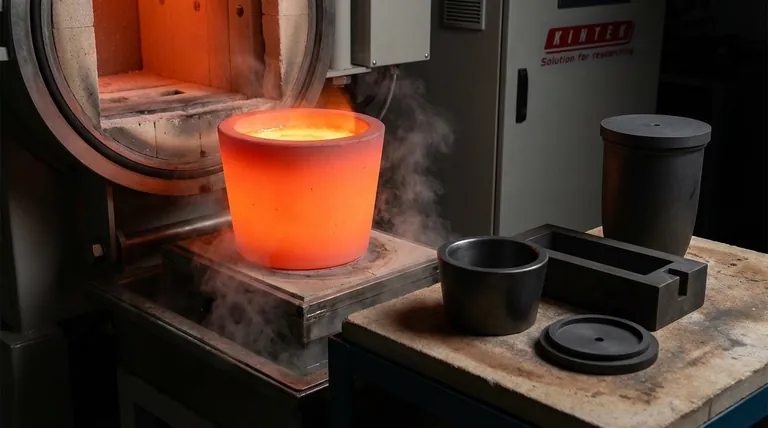In essence, a graphite crucible is used as a high-performance container for melting materials at extreme temperatures. Its primary role is to act as a highly efficient thermal barrier, which dramatically improves the speed and reduces the energy cost of processes like metal melting, casting, and material deposition.
The core purpose of using a graphite crucible isn't just to hold molten material. It's a strategic engineering choice to insulate the heat-intensive process, ensuring that energy is focused on the material itself rather than being lost to the surrounding equipment.

The Core Function: A High-Performance Thermal Barrier
A graphite crucible's value comes from its exceptional thermal properties, which allow it to perform two critical functions simultaneously: containment and insulation.
Containing the Melt at Extreme Temperatures
Graphite has a very high melting point (around 3,600°C or 6,500°F) and maintains its structural integrity at temperatures where most metals would liquefy. This makes it an ideal container for melting metals like gold, silver, copper, aluminum, and silicon.
Insulating from the Cooled Hearth
In many advanced processes, such as electron-beam evaporation, the crucible sits on a water-cooled hearth. This hearth is designed to draw away heat to protect the equipment.
A graphite crucible forms a crucial thermal barrier between the intensely hot molten material and the cold hearth, preventing massive energy loss.
The Practical Benefits of Thermal Efficiency
This insulating capability translates directly into significant gains in performance and cost savings, transforming the economics of the entire process.
Dramatically Increased Processing Speed
By preventing heat from escaping, the crucible ensures that more energy is directed into the target material.
This efficiency is so profound that deposition rates can increase by as much as 400% for the same amount of power applied, drastically increasing throughput.
Substantial Power Reduction
Alternatively, if maintaining a standard production rate is the goal, the crucible's efficiency allows for a major reduction in energy consumption.
The same deposition rate can often be achieved while reducing power input to as little as 25% of what would be required with a bare, uninsulated hearth.
Understanding the Trade-offs and Limitations
While powerful, a graphite crucible is not a universal solution. Its effectiveness depends on the specific material and environment.
Material Compatibility is Key
Graphite can react with certain metals, particularly ferrous metals like iron and steel, to form carbides. This can contaminate the melt and degrade the crucible itself.
For this reason, graphite is best suited for non-ferrous metals and other materials like silicon.
Risk of Oxidation
In the presence of oxygen at high temperatures, graphite will oxidize, or essentially burn away.
Therefore, graphite crucibles must be used in a vacuum or an inert gas atmosphere to ensure a reasonable service life.
Physical Brittleness
Graphite is a brittle material. It must be handled with care and protected from mechanical shock. It can also be susceptible to thermal shock if heated or cooled too rapidly, which can cause cracking.
Making the Right Choice for Your Goal
Selecting a graphite crucible is an engineering decision based on your primary objective.
- If your primary focus is maximum throughput: The crucible's ability to boost deposition rates by up to 400% makes it the clear choice for high-volume production.
- If your primary focus is energy efficiency and cost reduction: The potential to cut power consumption by 75% offers a direct path to lower operational expenses.
- If you are working with iron, steel, or other reactive metals: You must seek an alternative crucible material, such as alumina or another ceramic, to prevent melt contamination.
Ultimately, a graphite crucible is a strategic tool for mastering thermal management in high-temperature material processing.
Summary Table:
| Key Attribute | Benefit |
|---|---|
| High Melting Point (~3600°C) | Safely contains molten metals like gold, silver, and aluminum. |
| Superior Thermal Insulation | Prevents heat loss to water-cooled hearths, focusing energy on the material. |
| Increased Processing Speed | Can boost deposition rates by up to 400% for the same power input. |
| Major Energy Savings | Achieves the same results using as little as 25% of the power. |
| Material Compatibility | Ideal for non-ferrous metals; not suitable for reactive metals like iron. |
Ready to optimize your lab's high-temperature processes?
At KINTEK, we specialize in providing high-performance lab equipment, including crucibles designed for maximum thermal efficiency and durability. Whether your goal is to increase throughput or significantly reduce energy costs, our experts can help you select the right tool for your specific application.
Contact us today via our contact form to discuss how our solutions can enhance your metal melting, casting, and material deposition workflows.
Visual Guide

Related Products
- High Purity Pure Graphite Crucible for Electron Beam Evaporation
- High Purity Pure Graphite Crucible for Evaporation
- Engineering Advanced Fine Ceramics Alumina Crucibles (Al2O3) for Thermal Analysis TGA DTA
- Engineering Advanced Fine Ceramics Alumina Al2O3 Crucible With Lid Cylindrical Laboratory Crucible
- Arc-Shaped Alumina Ceramic Crucible High Temperature Resistant for Engineering Advanced Fine Ceramics
People Also Ask
- What are the effects of magnetron sputtering? Achieve High-Quality, Durable Thin Films for Your Lab
- What is a magnetron sputtering? A Guide to High-Quality Thin-Film Deposition
- What is sputtering technology? A Guide to Precision Thin Film Deposition
- What is the difference between VAR and ESR? A Guide to Understanding Tail Risk in Financial Modeling
- What is magnetron sputtering machine? Precision Thin-Film Deposition for Advanced Materials



















